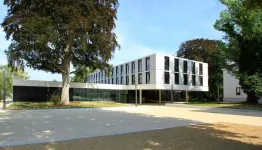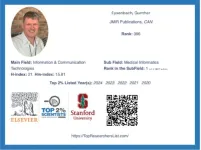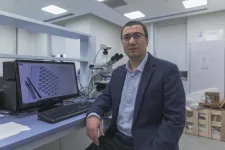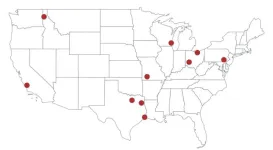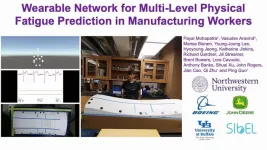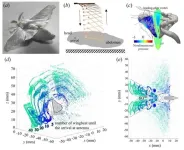(Press-News.org) Zeuthen, Germany – On 14 October 2024, the Cherenkov Telescope Array Observatory (CTAO), along with hosting partners and shareholders Deutsches Elektronen-Synchrotron DESY, celebrated the official inauguration of the Science Data Management Centre (SDMC) on the DESY campus in Zeuthen, Germany.
The ceremony, chaired by Prof. Christian Stegmann, Head of DESY Zeuthen, was opened by Mario Brandenburg, Parliamentary State Secretary at the German Federal Ministry of Education and Research (BMBF), and Tobias Dünow, State Secretary at the Ministry of Science, Research and Culture of the State of Brandenburg (MWFK), followed by a panel discussion with Dr. Stuart McMuldroch, CTAO Managing Director; Prof. Beate Heinemann, DESY Director for Particle Physics; and Prof. Otmar Wiestler, President of the Helmholtz Association. The event brought together members of the CTAO Council, key figures from the international CTAO community, political representatives, regional partners and CTAO and DESY staff to celebrate an important milestone in the exploration of the high-energy Universe.
Speaking about the importance of the new facility, Brandenburg states: “The opening of the Science Data Management Centre (SDMC) in Zeuthen marks a milestone on the way to the Cherenkov Telescope Array Observatory (CTAO). With the SDMC we are not only making a significant contribution to managing and processing the immense amounts of data generated by the CTAO observations. We also strengthen Germany's position as a location for innovation. The SDMC impressively demonstrates how international co-operation in research and the use of state-of-the-art data management technologies can enable future scientific breakthroughs.”
The CTAO is an international observatory with telescope array sites located on the Canary Island of La Palma, Spain, and in the Atacama Desert in Chile. Its Headquarters are located in Bologna, Italy. Located on the DESY campus, near Berlin, the CTAO SDMC coordinates the software and computing work of the Observatory, making CTAO‘s data products available to the worldwide community.
Tobias Dünow, State Secretary at the Ministry of Science, Research and Culture of the State of Brandenburg, said: “If you want to know why science and research are so immensely important and why every Euro invested there is an investment in the future, you just have to go to DESY in Zeuthen. DESY conducts research into questions of the future, from astroparticle physics to projects in the field of cancer therapy with accelerators and quantum computing, the answers to which will make our lives better and healthier. That is why we are delighted to have supported the construction of the Science Data Management Centre. The decision to locate the SDMC of the international gamma-ray observatory CTAO in Zeuthen is impressive proof of DESY's excellence in research."
The new €14 million building will accommodate 60 people and will be the home of the CTAO Science Data Management Centre and also host DESY offices and a new canteen.
“The opening of the SDMC represents a significant success and major milestone for the Observatory,“ explained Stuart McMuldroch during the inauguration. “The SDMC is a critical and essential part of our international effort to explore the high-energy Universe. It will provide essential data processing, software, and computing capabilities that significantly advance our mission. We are grateful to DESY and all those who made the SDMC a reality.”
Aligning with the regional importance of DESY, this is the first time an international research project will be co-hosted on the DESY Zeuthen campus, fostering top international research in Brandenburg and attracting scientist worldwide to work on its premises.
“We are very pleased that the CTAO is locating its SDMC on the DESY campus in Zeuthen, and we look forward to even closer co-operation with the Observatory, in particular the Headquarters of the CTAO in Bologna,” commented Christian Stegmann, during the moderation. “The decision underlines the positive development of DESY in Zeuthen into a centre for astroparticle physics.”
The sources the CTAO will study, like supermassive black holes and supernova remnants, are the most energetic objects in the Universe. The CTAO will provide a very wide energy range, excellent angular and energy resolution and sensitivity in comparison to any existing gamma-ray detector. With its ability to detect energies between 20 GeV and 300 TeV and its unprecedented resolution, the CTAO will be able to observe further than ever before, providing a completely new view of the sky.
“As one of Germany’s largest research centres, DESY carries out fundamental research that creates new knowledge and new conceptual approaches,” Beate Heinemann, DESY Director in charge of Particle Physics said. “DESY has a long tradition of performing research in international collaborations, not only to foster scientific progress but also to enable exchanges between people from many nations. I am delighted that DESY continues this tradition by hosting the SDMC of the CTAO. The large competence of DESY in data management and analysis will be pivotal to fully exploit the CTAO data, and to learn more about some of the most mysterious and violent objects in our Universe.”
Otmar Wiestler adds from the perspective of the President of the Helmholtz Association: “The CTAO enables groundbreaking discoveries in astrophysics and opens new pathways for our understanding of the universe. At the Helmholtz Association, we are proud to make another important contribution to this remarkable international research project with the opening of the CTAO’s SDMC at the German Electron Synchrotron DESY site in Zeuthen. The SDMC will be an excellent addition to the CTAO, serving as a central hub for processing and analyzing vast amounts of data, fostering long-term international collaboration, and thus making a significant contribution to the overall success of the project.”
About the CTAO
The CTAO will be the world’s largest and most powerful observatory for gamma-ray astronomy. The Observatory’s unique capabilities will help us to address some of the most perplexing questions in astrophysics, falling under three major themes: understanding the origin and role of relativistic cosmic particles; probing extreme environments, such as black holes or neutron stars; and exploring frontiers in physics, searching for dark matter or deviations from Einstein’s theory of relativity.
The CTAO is an international observatory with facilities located in Europe and South America: two arrays of telescopes in each hemisphere, CTAO-North in La Palma (Spain) and CTAO-South in the Atacama Desert (Chile), as well as the Headquarters in Bologna (Italy) and its Science Data Management Centre in Zeuthen (Germany).
The CTAO requires the collaboration and investment of a wide international network of countries and contributors. The Observatory is supported financially by a growing list of shareholders, which includes more than ten countries and an intergovernmental organisation. More than 1,500 people working in different international teams contribute to the implementation of the CTAO, as well as to its scientific, software and hardware development.
The CTAO was included in the 2008 roadmap of the European Strategy Forum on Research Infrastructures (ESFRI) and promoted to a Landmark project in 2018 and is a top-ranked priority amongst new ground-based infrastructure projects in ASTRONET’s “Roadmap 2022-2035: A Strategic Plan for European Astronomy.”
About the CTAO SDMC
The CTAO SDMC is one of the Observatory’s four core facilities. Located on the Deutsches Elektronen-Synchrotron DESY campus in Zeuthen, Germany, it serves as the scientific gateway for data received from the two telescope arrays and will coordinate both software and computing efforts, making CTAO's data products available to the worldwide community. This approach stems from CTAO’s commitment to Open Science, making it the first observatory of its kind to operate as an open, proposal-driven observatory providing public access to its high-level science data and software products.
The CTAO SDMC will be the home of the CTAO Computing Department. From handling the proposal submissions to the dissemination of data to scientists, the Computing team, with the support of In-Kind Contributors, is working to develop a package of hardware and software products to support the flow of data. Operating from the CTAO SDMC, they will coordinate with several off-site data centre partners for the Observatory’s data processing and simulation needs and are directly responsible for the installation of the on-site data centres and control rooms at the two array sites.
More information, including a FAQ document about the CTAO and its SDMC, as well as images from the event are available on the website: https://www.ctao.org/news/ctao-sdmc-inauguration/
END
New hub for high-energy astrophysics — CTAO Science Data Management Centre opens at DESY in Zeuthen
2024-10-15
ELSE PRESS RELEASES FROM THIS DATE:
JMIR publications CEO and Executive Editor Gunther Eysenbach achieves #1 ranking as most cited researcher in Medical Informatics for fifth consecutive year
2024-10-15
Toronto, ON (October 14, 2024) – JMIR Publications is proud to announce that Gunther Eysenbach, founder, CEO and executive editor, has once again been named the #1 most cited researcher in the subfield of medical informatics by Stanford/Elsevier’s Top 2% Scientists rankings. This marks the fifth consecutive year that Dr Eysenbach has secured this prestigious position, reaffirming his status as a leading authority and driving force in the field. He is also ranked #36 in the Top 100 Scientists in Information & Communication ...
ERC grant for groundbreaking wearable health tech
2024-10-15
Dr. Levent Beker from the Department of Mechanical Engineering at Koç University, once again received European Research Council (ERC) support for his scientific research that focuses on improving the quality of our daily lives.
His previous project on an implant that can detect signs of heart failure and degrade in the body without surgery was granted €2.5 million Starting Grant from the ERC. Last year, his research on a wireless micro sensor that enables real-time monitoring of food spoilage at supermarkets, was published in Nature FoodMagazine.
Currently leading the Bio-integrated ...
NIH announces winners of prize competition to improve postpartum maternal health and health equity through innovative diagnostics
2024-10-15
The National Institutes of Health (NIH) has announced the winners of the Rapid Acceleration of Diagnostics Technology (RADx® Tech) for Maternal Health Challenge, an $8 million prize competition to encourage development of postpartum maternal health diagnostics for use in regions that have limited access to maternity care. The eight winning teams developed home-based and point-of-care diagnostics, wearables and other accessible technologies to improve postpartum health outcomes during the period when most maternal deaths occur—up to one year after delivery or the end of ...
APS and SPR honor Dr. Cynthia F. Bearer with the 2025 Mary Ellen Avery Neonatal Research Award
2024-10-15
October 15, 2024 – The American Pediatric Society (APS) and the Society for Pediatric Research (SPR) are pleased to announce Cynthia F. Bearer, MD, PhD, as the 2025 Mary Ellen Avery Neonatal Research Award recipient. This award honors a pediatric investigator who has made important contributions to neonatal health through basic or translational research.
Dr. Bearer is the William & Lois Briggs Chair of Neonatology and Chief, Division of Neonatology, Rainbow Babies & Children’s Hospital and Professor of Pediatrics & Neurosciences at Case Western Reserve University. ...
Election delays and voter trust
2024-10-15
A pre-registered survey of nearly 10,000 Americans shows that delays in declaring the winners of elections cause distrust in the electoral process, but that reassuring voters before polls close that delays are normal can prevent this distrust from taking root. National elections in the United States were not definitively settled for days after election day in 2020 and 2022. There are legitimate reasons for such delays, including state rules about when counting can commence and laws about whether mailed ballots postmarked on election day must be counted. However, delayed results ...
US air pollution monitoring network has gaps in coverage, say researchers
2024-10-15
The lack of air-quality monitoring capabilities across the U.S. affects the health of millions of people and disproportionately impacts minority and low socioeconomic-status communities, say researchers in ACS’ Environmental Science & Technology Letters. Motivated by a new U.S. Environmental Protection Agency (EPA) standard for air pollution, the team employed a model for fine-scale air pollution mapping using real-world data, and it indicates there is an urgent need to address gaps in the agency’s monitoring ...
Continuous monitoring of fatigue in factory workers
2024-10-15
A system of wearable sensors and machine learning can continuously monitor factory workers for signs of physical fatigue. Factory work can be physically strenuous, and a safe and ethical workplace must ensure that workers do not become overly fatigued, which can increase the risk of injury and accident, cause chronic health problems, and also impair performance. A system designed by Ping Guo, Qi Zhu, and colleagues measures heart rate, heart rate variability, skin temperature, and locomotor patterns ...
Farmer ants’ wearable bacteria
2024-10-15
A study investigates the evolution of beneficial bacteria that live inside and on the surface of farming ants. Attine ants farm fungi, in one of the natural world’s best-studied mutualistic symbioses. In the 1990s, the picture of this mutualism was expanded to include another partner: an actinobacteria, Pseudonocardia, which lives on the ants’ cuticle—their hard exoskeleton—where its cultures are fed by secretions of subcuticular glands. Pseudonocardia is known to kill the fungal pathogen Escovopsis, that might destroy the ants’ mutualistic fungus. Jacobus J. Boomsma and colleagues sequenced samples ...
Political polarization and trust
2024-10-15
A collection of 15 articles from the Polarization and Trust Special Feature explores the complex nature of the emotional divide between political opponents, using approaches from a variety of disciplines, including political science, psychology, sociology, and economics. The articles emerged from a 2023 workshop on “Directions of Polarization, Social Norms, and Trust in Societies,” held at MIT and organized by Kati Kish Bar-On, Eugen Dimant, Yphtach Lelkes and David Rand. Researchers from a number of teams identified ways in which partisans mistrust and inaccurately perceive their political opponents, and other teams examined why such inaccurate ...
Study uncovers how silkworm moth's odor detection may improve robotics
2024-10-15
The silkworm moth (Bombyx mori) is an insect that no longer flies due to domestication. The males use their antennae to detect pheromones emitted by females and respond very acutely, and have been used as model insects for the study of their odor source localization. Flying insects flap their wings when they fly, and silkworm moths are also known to flap their wings (called fanning) when they detect pheromones, even though they do not fly. As pheromone molecules move through space in the air, the air flows ...
